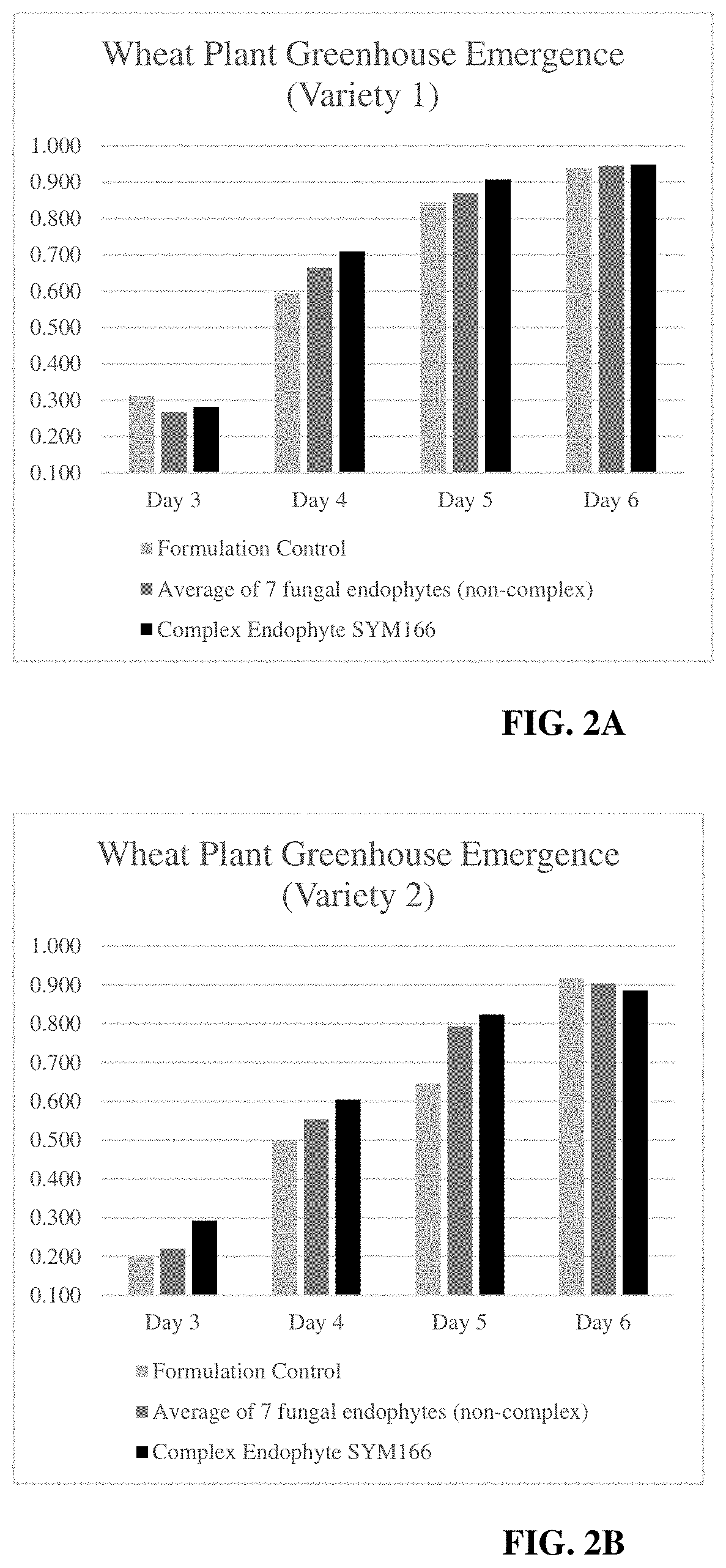Isolated Complex Endophyte Compositions and Methods for Improved Plant Traits
a technology of complex endophyte and composition, which is applied in the field of composition and methods for improving the cultivation of plants, can solve the problems of biotic and abiotic stress resilience improvement, lack of acceptance of many gm traits, and exclusion of gm crops and many synthetic chemistries from some global markets, and achieves the improvement of crop resilience to biotic and abiotic stresses, facilitate the stability, storage and/or application of endophyte composition, and reduce seed
- Summary
- Abstract
- Description
- Claims
- Application Information
AI Technical Summary
Benefits of technology
Problems solved by technology
Method used
Image
Examples
example 1
Isolation of Plant-Derived Complex Endophytes
[0271]Isolation followed the methods described in Hoffman and Arnold (2010, Appl. Environ. Microbiol. 76: 4063-4075). Briefly, fresh, asymptomatic tissue was collected from at least three healthy, mature individuals of each focal species. Material was transferred to the laboratory for processing within 6 to 12 h of collection. Tissue samples were washed in running tap water and then cut into 2-mm segments. Segments were surface sterilized by rinsing in 95% ethanol for 30 s, 10% Clorox (0.6% sodium hypochlorite) for 2 min, and 70% ethanol for 2 min, allowed to surface dry under sterile conditions, and plated on 2% malt extract agar (MEA), which encouraged growth by a diversity of endophytes.
example 2
Identification of Complex Endophyte Host Fungi, Endofungal Bacteria, and Endofungal Fungi
[0272]Total genomic DNA was extracted from individual fungal isolates obtained as described above, using the Qiagen DNeasy Plant Mini Kit. PCR was used to amplify the nuclear ribosomal internal transcribed spacers (ITS) and the 5.8S gene (ITS ribosomal DNA [rDNA]) and when possible the first 600 bp of the large subunit (LSU rDNA) as a single fragment (ca. 1,000 to 1,200 bp in length) using the primers ITS1F and ITS4 or LR3. Each 25 microliter reaction mixture included 22.5 microliters of Invitrogen Platinum Taq supermix, 0.5 microliter of each primer (10 uM), and 1.5 microliter of DNA template (˜2-4 ng). Cycling reactions were run with MJ Research PTC thermocyclers and consisted of 94° C. for 5 min, 35 cycles of 94° C. for 30 s, 54° C. for 30 s, and 72° C. for 1 min, and 72° C. for 10 min. Sanger sequencing was performed using an ABI 3730xl DNA Analyzers for capillary electrophoresis and fluores...
example 3
Characterization of Complex Endophytes
[0279]Complex endophytes have unique properties or may produce unique substances that may be beneficial to a plant. Even if an endofungal bacterial endophyte has previously been characterized, its introduction into a host fungus may change its behavior, especially by adding novel functions to the symbiotic coupling. The in vitro activities of complex endophytes can be tested using the following colorimetric or growth-based assays. Host fungi, endofungal bacterial endophytes, and endofungal fungal endophytes may also be tested using these assays.
Growth on Nitrogen Free LGI Media
[0280]All glassware is cleaned with 6M HCl before media preparation. A new 48 well plate (600 microliter well volume) is filled with 500 microliters / well of sterile LGI agar [per L, 50 g Sucrose, 0.01 g FeCl3-6H2O, 0.02 g CaCl2, 0.8 g K3PO4, 0.2 g CaCl2, 0.2 g MgSO4-7H2O, 0.002 g Na2MoO4-2H2O, Agar 15 g, pH 7.5]. Microbes are inoculated into the 48 wells with a flame-steri...
PUM
 Login to View More
Login to View More Abstract
Description
Claims
Application Information
 Login to View More
Login to View More - R&D
- Intellectual Property
- Life Sciences
- Materials
- Tech Scout
- Unparalleled Data Quality
- Higher Quality Content
- 60% Fewer Hallucinations
Browse by: Latest US Patents, China's latest patents, Technical Efficacy Thesaurus, Application Domain, Technology Topic, Popular Technical Reports.
© 2025 PatSnap. All rights reserved.Legal|Privacy policy|Modern Slavery Act Transparency Statement|Sitemap|About US| Contact US: help@patsnap.com



